The new Samsung Portable SSD T9 is the last addition to the company’s high-performance line of portable storage solutions. Targeted at content creators who require seamless data transfers and ample storage for their resource-intensive tasks, the T9 offers a slew of features that not only make it an attractive option but also an essential tool in the modern digital workspace. It is available in capacities ranging from 1TB to 4TB, features a “luxury carbon pattern” design, and is purpose-built to offer consumers and professionals a fine balance between functionality, aesthetics, and performance.
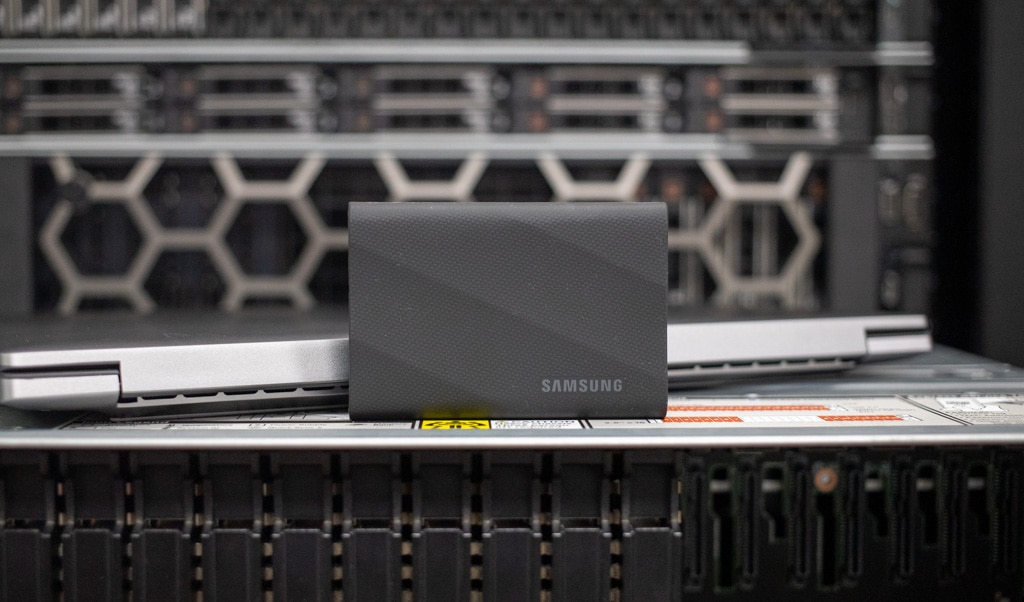
Samsung Portable SSD T9 Performance Profile
What sets the T9 apart from the other drives in the T series is its new performance capabilities. The drive leverages the USB 3.2 Gen 2×2 interface to achieve some potential high-speed data transfer speeds—up to 2,000MB/s for sequential read and nearly the same for sequential writes.
The USB 3.2 Gen2 (i.e., the Samsung T7) and USB 3.2 Gen2x2 (Samsung T9) differ significantly in their potential data transfer rates and the number of lanes used for data transmission. Gen2 offers a maximum rate of 10 Gbps using a single lane, while Gen2x2 doubles it to 20 Gbps by using two separate lanes.
Samsung indicates its TurboWrite technology further amplifies its performance by offering a high-performance buffer of up to 180GB, making large file transfers or video encoding tasks a breeze. For content creators dealing with 8K or 12K footage, the T9 promises not just speed but sustained performance, which is crucial to avoid frame drops during high-resolution video shooting.
Samsung Portable SSD T9 Features
The Samsung Magician SSD management software package adds significant value to the T9, incorporating performance benchmarking, firmware updates, security functions, and real-time health status checks. With the new 8.0 version on the horizon, this further integrates data migration tools, portable SSD software, and card authentication, providing a one-stop solution for managing your drive.
The T9 also focuses on power consumption and thermal management. With an idle power consumption of 0.67W and peak power usage of up to 7.3W, the device is optimized for energy efficiency. According to Samsung, it offers up to 30 more minutes of battery life in PCMark 10 Battery Life benchmarks compared to competitors. Its heat dissipation mechanism uses materials like silicon and aluminum to ensure that performance doesn’t drop due to overheating, a crucial aspect for professionals who can’t afford to lose data or sustained performance.
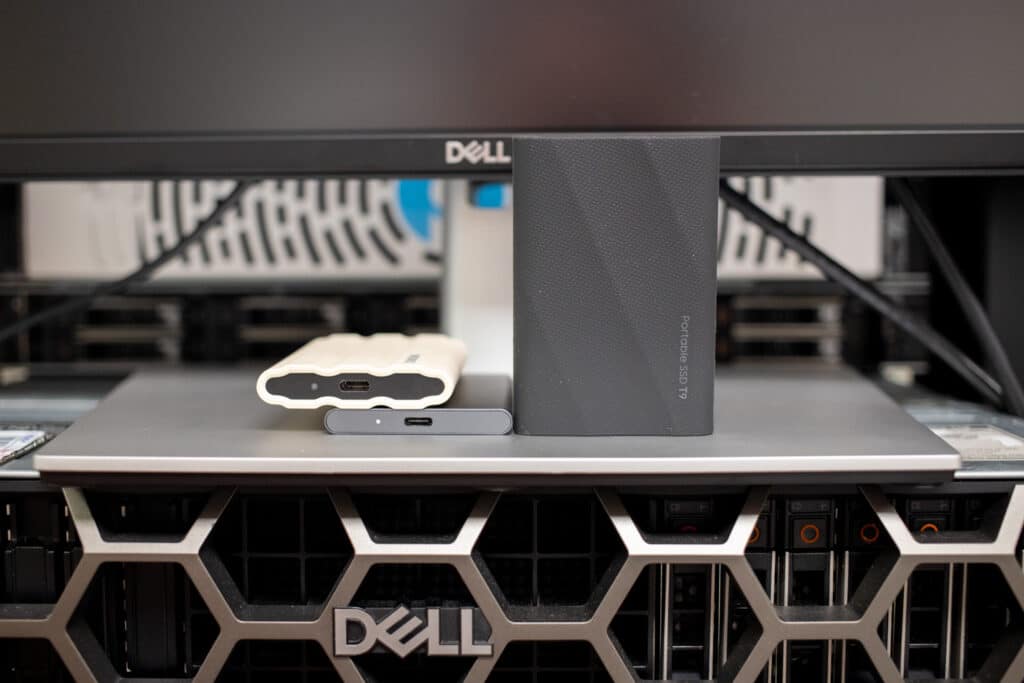
Compatibility with a wide range of devices is another key feature of the T9. The drive can be connected to PCs, Macs, tablets, mobile phones, game consoles, and even professional cameras, offering a flexible data storage and transfer solution. And for those who worry about dropping their expensive equipment, rest easy knowing the T9 can withstand drops of up to three meters thanks to its strong internal aluminum body coated with durable rubber.
The T9 also comes with a range of security features, such as AES 256-bit hardware encryption, ensuring that your data remains secure, yet easily accessible to you.
Samsung Portable SSD T9 Design and Build
The first thing you’ll notice about the Samsung Portable SSD T9 is its very sleek and unique design, which certainly reaffirms the company’s ‘luxury added to ruggedness’ tagline. The device has an exterior with curved diagonal lines and reverse carbon patterns, making it feel like an expensive wallet in your hand. It’s not just about the looks, though, as the rubberized exterior also offers a comfortable and secure grip to help prevent accidental drops.
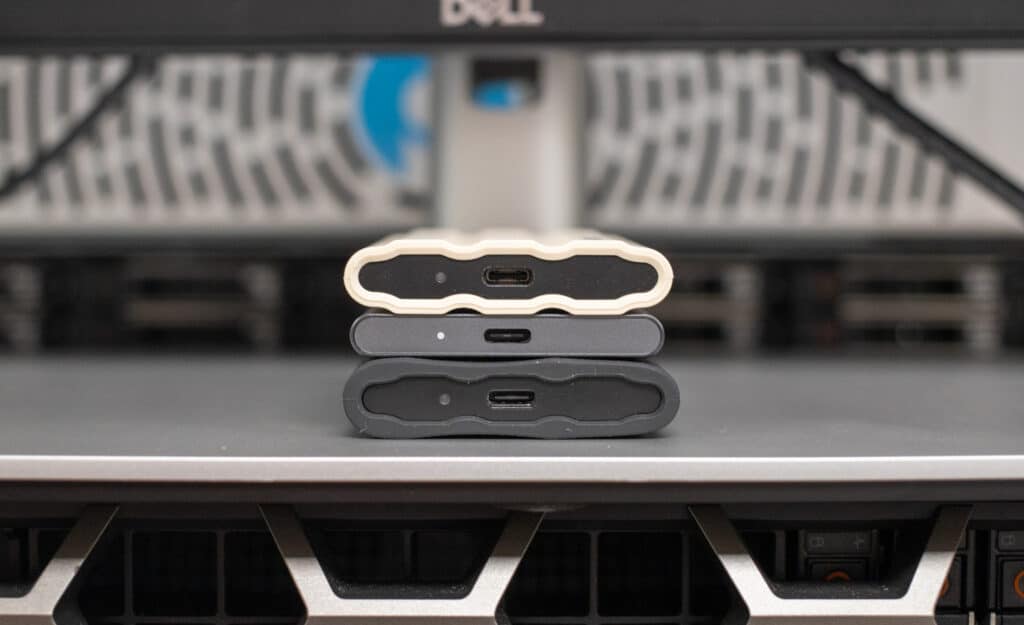
Samsung T7 Shield, T7, T9 Stacked
At the core of its build is a solid aluminum body designed to absorb shocks and resist damage. As such, Samsung indicates that the T9 is built to withstand drops of up to three meters, making it one of the more durable SSDs on the market. You can carry it with certain confidence that knocks, jolts, or accidental spills won’t ruin your important data.
Heat management is another area where Samsung has put some focus. Given that overheating is a concern for high-performance drives, Samsung has engineered the T9 with excellent thermal control capabilities. To achieve this, it leverages a blend of thermal interface materials, including silicon and aluminum, to ensure optimal heat dissipation. In theory, this allows you to transfer large files, edit videos, and even shoot in high resolution for extended periods without worrying about performance degradation.
Samsung T9 vs. Samsung T7
It’s worth comparing it to its incredibly successful predecessor, the Samsung T7. While the T7 was already specced with impressive potential speeds of 1GB/s via USB 3.2 Gen2, Samsung claims the T9 doubles that performance with its Gen2x2 interface. This twofold increase in speed is certainly a valuable upgrade for many professionals who need to meet deadlines and deal with large files.
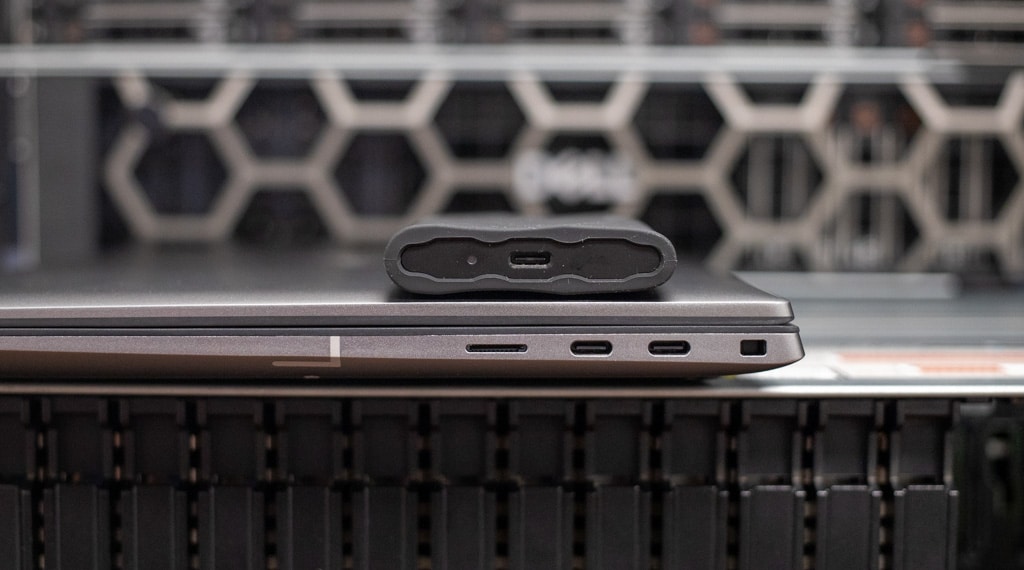
Nonetheless, while the T7 did offer some level of ruggedness and security features, it didn’t go as far as providing a high-performance buffer like the T9’s TurboWrite, nor did it offer the same luxury feel or thermal efficiencies. And although both drives provide extensive device compatibility, the T9 takes it a step further with its exhaustive verification against 64 host devices, ensuring even broader compatibility and reliability. It is worth noting the T7 comes in a SHield model as well with additional physical protection.
Samsung Portable SSD T9 Warranty and Pricing
Backed by a 5-year warranty, the Samsung T9 goes for $140 (1TB), $240 (2TB), and $440 (4TB). We will be looking at the 4TB model for this review.
Samsung Portable SSD T9 Specifications
| Interface | USB 3.2 Gen 2×2 (20Gbps) | ||||
| Hardware Information | Capacity | 1TB | 2TB | 4TB | |
| Dimensions | 88 x 60 x 14mm | ||||
| Weight | 122 grams | ||||
| Performance | Sequential Read | Up to 2,000 MB/sec | Up to 2,000 MB/s | Up to 2,000 MB/s | |
| Sequential Write | Up to 1,950 MB/s | Up to 1,950 MB/s | Up to 2,000 MB/s | ||
| Durability | Drop Resistant | Up to 3 meters | |||
| Security | Encryption | AES 256-bit hardware encryption | |||
| Software | Samsung Portable SSD 1.05 Samsung Magician Software | ||||
| Reliability |
Temperature |
Operating | 0°C to 60°C6 | ||
| Non-Operating | -40°C to 85°C | ||||
| Humidity | 5% to 95% non-condensing | ||||
| Shock | Non-Operating | 1,500G, duration: 0.5ms, 3 axis | |||
| Vibration | Non-Operating | 20~2,000Hz, 20G | |||
| Certifications | CE, BSMI, KC, VCCI, RCM, FCC, IC, UL, TUV, CB, EAC, UKCA, BIS | ||||
| RoHS Compliance | RoHS 2 | ||||
| Warranty | Five (5) Year Limited Warranty | ||||
Samsung Portable SSD T9 Performance
Blackmagic Disk Speed Test
We first conducted the BlackMagic disk speed test on the Samsung T9, spanning approximately 20 minutes.
Here, the Samsung T9 achieved 1,566MB/s read and 1,581.6MB/s write. As expected, this is essentially double the speeds of the Samsung T7 (both the 4TB shield and 2TB original).
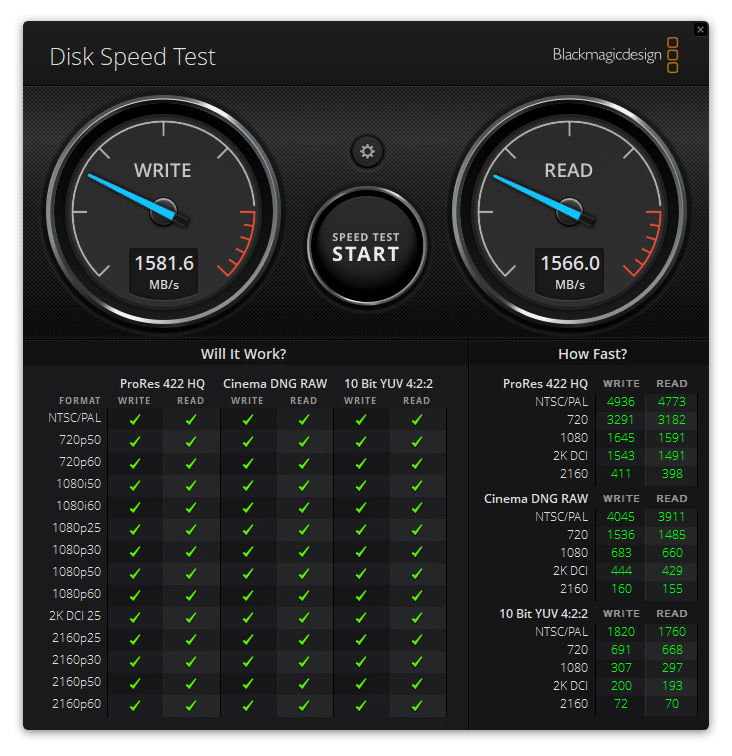
Here is a quick rundown of disk speed performance for other portables:
- Crucial X10 Pro (2023, USB 3.2 Gen2x2): 1,723.1MB/s read, 1,564.0MB/s write
- Corsair EX100U SSD (2022, USB 3.2 Gen2x2): 1,241.3MB/s read, 1,331MB/s write
- SanDisk Extreme Pro V2 (2022, USB 3.2 Gen2x2): 1.56GB/s read, 1.75GB/s write
- Samsung T7 (2020, USB 3.2 Gen2): 894MB/s read, 840MB/s write
- Samsung Portable SSD T7 Shield (2023, USB 3.2 Gen2): 893.8MB/s read, 936.5MB/s write
- Sabrent Nano XTRM (2023, USB 3.2 Gen2): 956.6MB/s read, 929.8MB/s write
IOMeter Performance
The next test is IOMeter on a Windows rig. Here, we looked at 2MB sequential read/write, 2MB random read/write, and 4K random read/write using the USB 3.2 Gen2x2 interface. These tests gauge its performance in tasks ranging from large file transfers to everyday computing activities.
In these benchmarks, we will be comparing it to the SanDisk Extreme Pro V2 (an older USB 3.2 Gen2x2 portable), the Samsung Portable SSD T7 Shield (to show the improvement over the two USB interfaces), and the SanDisk PRO-G40 (to compare Thunderbolt 3 speeds).
In our first test, we used a 1-Thread workload:
| IOMeter (1 Thread) |
Samsung T9 USB 3.2 Gen2x2 |
Crucial X10 Pro USB 3.2 Gen2x2 |
SanDisk Extreme Pro V2 USB 3.2 Gen2x2 |
Samsung T7 Shield USB 3.2 Gen2 |
| Seq 2MB Write | 1,284MB/s | 1,273.3MB/s | 1.5GB/s | 804.4MB/s |
| Seq 2MB Read | 1,355MB/s | 1,591.5MB/s | 1.43GB/s | 765.6MB/s |
| Random 2MB Write | 1,278MB/s | 1,104.1MB/s | 1.44GB/s | 805.2MB/s |
| Random 2MB Read | 1,117MB/s | 1,242.8MB/s | 1.35GB/s | 757.8MB/s |
| Random 4K Write | 16,643 IOPS | 19,988 IOPS | 20,228 IOPS | 13,610 IOPS |
| Random 4K Read | 4,441 IOPS | 4,609 IOPS | 7,681 IOPS | 3,791 IOPS |
Overall, the T9 performed very well, though it fell slightly behind the SanDisk PRO-BLADE in all of the results.
When upping the thread count to 4, the Samsung T9 demonstrated better results (as expected). Here, it showed similar results compared to its more direct competitor, the Crucial X10 Pro, though it fell behind quite a bit in random 2MB reads and random 4k writes. The impressive SanDisk Extreme Pro showed superior performance across the board again. You also can see the huge performance gains over its predecessor (T7) due to the Gen2x2 interface.
Here is a rundown of the results:
| IOMeter (4 Threads) |
Samsung T9 USB 3.2 Gen2x2 |
Crucial X10 Pro USB 3.2 Gen2x2 |
SanDisk Extreme Pro V2 USB 3.2 Gen2x2 |
Samsung T7 Shield USB 3.2 Gen2 |
| Seq 2MB Write | 1,766MB/s | 1,736.2MB/s | 1.98GB/s | 1,018MB/s |
| Seq 2MB Read | 1,944MB/s | 1,966.9MB/s | 1.99GB/s | 1,042MB/s |
| Random 2MB Write | 1,493MB/s | 1,447.9MB/s | 1.84GB/s | 1,000MB/s |
| Random 2MB Read | 1,468MB/s | 1,863.8MB/s | 1.58GB/s | 1,019MB/s |
| Random 4K Write | 32,358 IOPS | 67,206 IOPS | 66,389 IOPS | 17,909 IOPS |
| Random 4K Read | 18,925 IOPS | 15,333 IOPS | 32,689 IOPS | 15,347 IOPS |
Conclusion
The new Samsung T9 portable SSD represents the latest addition to Samsung’s incredibly popular, high-performance portable storage lineup, catering to content creators who demand speedy data transfers and generous storage capacities, which range from 1TB to 4TB.
What sets the T9 apart from its predecessor is its utilization of the USB 3.2 Gen 2×2 interface, which translates into significantly better sequential read and write speeds, making it an ideal tool for handling data-intensive tasks. Moreover, it introduces TurboWrite technology, which offers a substantial performance buffer, particularly beneficial for professionals dealing with resource-intensive projects like 8K and 12K video editing. The Samsung T9 impresses not only with its high performance but also its user-friendly features, including the industry-best Samsung Magician SSD management software.
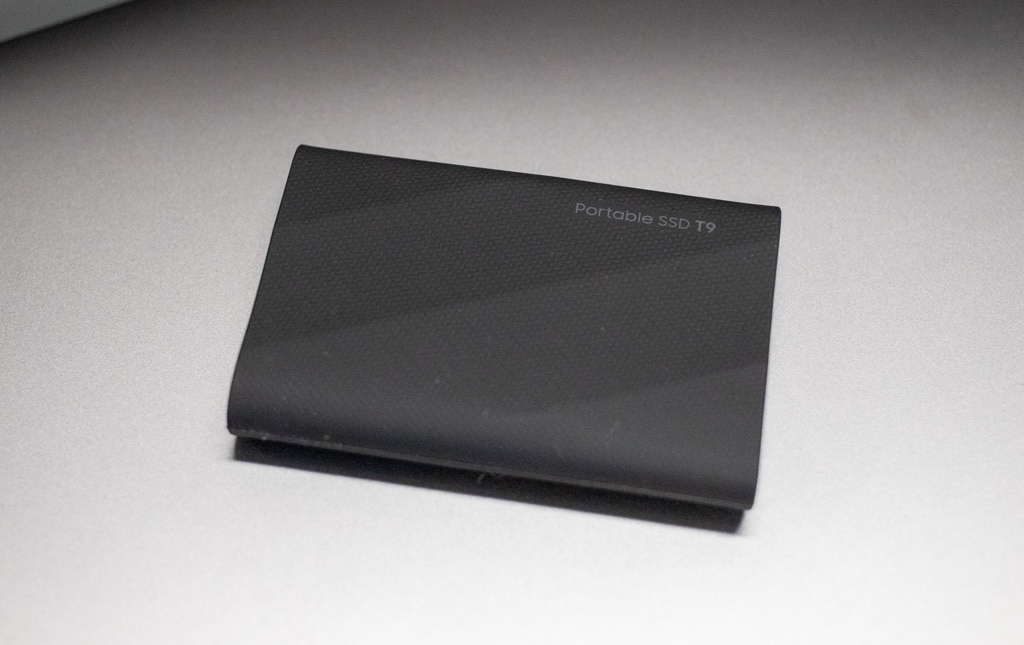
Comparing the Samsung T9 to the T7 showcases a range of notable improvements, including overall performance, build quality, and thermal management. For example, it hit 1,944MB/s in sequential reads during our 4-thread IOMeter test, which was essentially double the speed of the T7, with results across the board showing a range of 35% to 100% improvement in performance over its predecessor. Moreover, its build quality is also a serious improvement over the T7 with its unique design, all-aluminum build, and rubberized exterior.
It’s worth noting that the SanDisk Extreme Pro V2 (another recent USB 3.2 Gen 2×2 portable) outpaces the T9 in every category while the Crucial X10 Pro showed slightly better results than the new Samsung drive. Therefore, the decision between the T9 and these other portables hinges on the drive’s features, support, build quality, and pricing, aligning with the specific requirements and preferences of users.
For example, the Samsung T9 is priced at $140 (1TB), $240 (2TB), and $440 (4TB). On the other hand, the SanDisk Extreme Pro V2 is currently on sale for $120, $220, and $400 while the Crucial X10 Pro goes for roughly $120, $170, and $290. Coupling this slightly better pricing profile and superior performance makes the SanDisk Extreme PRO V2 seem like the more compelling option for the moment; likewise for the Crucial drive. That is until Samsung drives down the price, which usually happens quickly after release.
Ultimately though, the Samsung T9 has a lot going for it with its best-of-class SSD management software (which is getting even better with the impending 8.0 release), well-thought-out design and build, and the company’s pedigree for well-made portables. It is a fully rounded package with substantial improvements over its predecessor, meeting almost every criterion that one could set for an external storage device.




 Amazon
Amazon